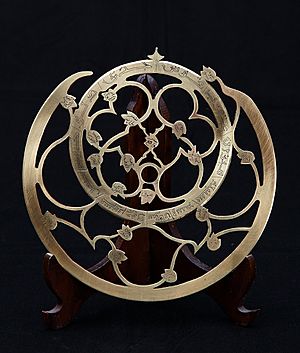Alloy facts for kids
An alloy is a special kind of mixture. It's made by combining two or more different chemical elements. At least one of these elements must be a metal. The cool thing about alloys is that they have different properties than the metals they are made from.
Most alloys are created by melting metals together. While they are liquid, they are mixed to form a solution. Then, they are left to cool down and become solid again.
Contents
Alloys: Stronger and Better Metals
Combining a pure metal with other metals or non-metals often makes it much better. For example, steel is an alloy made mostly from iron. But steel is much stronger and more useful than pure iron.
Some physical properties like density or how well they conduct electricity or heat might not change much. However, important properties like strength can be very different and much improved in an alloy.
The Story of Bronze
The very first alloy ever discovered was Bronze. Bronze is made by mixing copper and tin. People found out about bronze a very long time ago, in prehistoric times. This period was even named the Bronze Age because bronze was so important. It was used for making tools and weapons.
Later, even better alloys were discovered. These new alloys replaced bronze for many tools and weapons. Today, bronze is still used for beautiful things like ornaments, statues, and bells. Another common alloy is Brass, which is made from copper and zinc.
How Alloys Melt
When a solid changes to liquid, we call that its Melting point. Most alloys don't have just one melting point. Instead, they have a melting range. In this range, the alloy is a mix of both solid and liquid at the same time.
The temperature where melting just begins is called the solidus. The temperature where all the melting is finally finished is called the liquidus.
Understanding Alloy Terms
The word "alloy" means a mixture of atoms. The main substance, or the biggest part of the mixture, is always a metal. This main metal is often called the base or matrix.
Types of Alloys by Number of Elements
Alloys can be named based on how many different types of atoms they contain:
- If an alloy has only two types of atoms, like copper and nickel, it's called a binary alloy.
- If an alloy has three types of atoms, like iron, nickel, and chromium, it's called a ternary alloy.
- An alloy with four types of atoms is a quaternary alloy.
- An alloy with five types of atoms is a quinary alloy.
Alloy Systems
You can make many different versions of an alloy from the same basic materials. These different versions are made by using different amounts of each material. The entire group of all possible versions of an alloy is called a system.
For example, all the different forms of an alloy that have only two main ingredients are called a binary system. If an alloy has three main ingredients, all its forms are part of a ternary system.
Common Alloys You See Every Day
Here are some common alloys and what they are used for:
- Brass is made of about 35% zinc and 65% copper. It's used for musical instruments, jewellery, faucets, and decorative hardware.
- Stainless steel is mostly iron, with more than 11% chromium, and different amounts of nickel and carbon. It's used for tableware, cookware, and surgical tools.
- Steel is made of about 99% iron and 1% carbon. It's used for tools, car bodies, machinery, girders (strong beams), and rails for trains.
- Bronze is mostly copper with some tin. It's used for boat hardware, screws, and decorative grill work.
- Alnico is a mix of aluminium, nickel, and cobalt. It's used to make strong, permanent magnets.
Images for kids
-
Liquid bronze, being poured into molds during casting
-
A brass lamp
-
Photomicrographs of steel. Top photo: Annealed (slowly cooled) steel forms a layered structure called pearlite, made of cementite (light) and ferrite (dark). Bottom photo: Quenched (quickly cooled) steel forms a single structure called martensite, where carbon is trapped, creating internal stresses.
-
A meteorite and a hatchet forged from meteoric iron
-
Bronze axe from 1100 BC
-
A bronze doorknocker
-
Puddling in China, around 1637. Unlike most alloying, liquid pig-iron is stirred to remove carbon, leaving behind mild steel to wrought iron.
See also
 In Spanish: Aleación para niños
In Spanish: Aleación para niños












